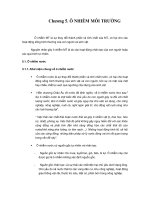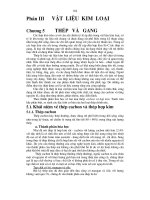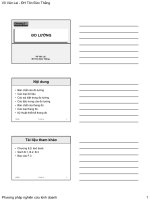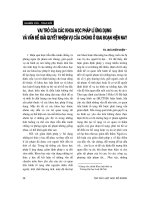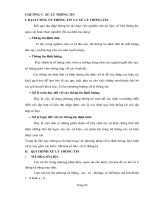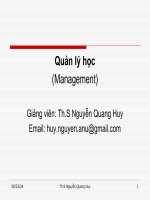SLIDE KHÓA học PHÁP lý CHƯƠNG 5 processing crime and incident scenes
Bạn đang xem bản rút gọn của tài liệu. Xem và tải ngay bản đầy đủ của tài liệu tại đây (2.63 MB, 91 trang )
.c
om
du
o
ng
th
an
co
ng
Guide to Computer Forensics
and Investigations
Fourth Edition
cu
u
Chapter 5
Processing Crime and Incident
Scenes
CuuDuongThanCong.com
/>
.c
om
Objectives
cu
u
du
o
ng
th
an
co
ng
• Explain the rules for digital evidence
• Describe how to collect evidence at private-sector
incident scenes
• Explain guidelines for processing law enforcement
crime scenes
• List the steps in preparing for an evidence search
• Describe how to secure a computer incident or
crime scene
CuuDuongThanCong.com
/>
.c
om
Objectives (continued)
cu
u
du
o
ng
th
an
co
ng
• Explain guidelines for seizing digital evidence at
the scene
• List procedures for storing digital evidence
• Explain how to obtain a digital hash
• Review a case to identify requirements and plan
your investigation
CuuDuongThanCong.com
/>
.c
om
ng
co
an
cu
u
du
o
ng
th
Identifying Digital Evidence
CuuDuongThanCong.com
/>
.c
om
Identifying Digital Evidence
ng
• Digital evidence
an
co
– Can be any information stored or transmitted in
digital form
ng
th
• U.S. courts accept digital evidence as physical
evidence
du
o
– Digital data is a tangible object
cu
u
• Some require that all digital evidence be printed out
to be presented in court
CuuDuongThanCong.com
/>
.c
om
Identifying Digital Evidence
(continued)
co
ng
• General tasks investigators perform when working
with digital evidence:
cu
u
du
o
ng
th
an
– Identify digital information or artifacts that can be
used as evidence
– Collect, preserve, and document evidence
– Analyze, identify, and organize evidence
– Rebuild evidence or repeat a situation to verify that
the results can be reproduced reliably
• Collecting computers and processing a criminal or
incident scene must be done systematically
CuuDuongThanCong.com
/>
.c
om
Understanding Rules of Evidence
cu
u
du
o
ng
th
an
co
ng
• Consistent practices help verify your work and
enhance your credibility
• Comply with your state’s rules of evidence or with
the Federal Rules of Evidence
• Evidence admitted in a criminal case can be used
in a civil suit, and vice versa
• Keep current on the latest rulings and directives on
collecting, processing, storing, and admitting digital
evidence
CuuDuongThanCong.com
/>
.c
om
Understanding Rules of Evidence
(continued)
co
ng
• Data you discover from a forensic examination falls
under your state’s rules of evidence
an
– Or the Federal Rules of Evidence
ng
th
• Digital evidence is unlike other physical evidence
because it can be changed more easily
cu
u
du
o
– The only way to detect these changes is to compare
the original data with a duplicate
• Most federal courts have interpreted computer
records as hearsay evidence
– Hearsay is secondhand or indirect evidence
CuuDuongThanCong.com
/>
ng
• Business-record exception
.c
om
Understanding Rules of Evidence
(continued)
th
an
co
– Allows “records of regularly conducted activity,” such
as business memos, reports, records, or data
compilations
cu
u
du
o
ng
• Generally, computer records are considered
admissible if they qualify as a business record
• Computer records are usually divided into:
– Computer-generated records
– Computer-stored records
CuuDuongThanCong.com
/>
.c
om
Understanding Rules of Evidence
(continued)
co
ng
• Computer records must be shown to be authentic
and trustworthy
an
– To be admitted into court
ng
th
• Computer-generated records are considered
authentic
cu
u
du
o
– If the program that created the output is functioning
correctly
• Collecting evidence according to the proper steps
of evidence control helps ensure that the computer
evidence is authentic
CuuDuongThanCong.com
/>
.c
om
Understanding Rules of Evidence
(continued)
ng
• When attorneys challenge digital evidence
an
co
– Often they raise the issue of whether computergenerated records were altered
th
• Or damaged after they were created
u
du
o
ng
• One test to prove that computer-stored records are
authentic is to demonstrate that a specific person
created the records
cu
– The author of a Microsoft Word document can be
identified by using file metadata
CuuDuongThanCong.com
/>
.c
om
Demo: Metadata in FTK
u
du
o
ng
th
an
co
Click No, OK, OK through the demo warning boxes
Go directly to working with program
File, Add Evidence
Enter your name, Next, Next
Click "Add Evidence" button
Click "Individual File", Continue
Navigate to Word document,double-click it
OK, Next, Continue
cu
–
–
–
–
–
–
–
–
ng
• Save a Word document
• In FTK:
CuuDuongThanCong.com
/>
.c
om
FTK Demo
cu
u
du
o
ng
th
an
co
ng
• In "File Category", click the Documents button
• Select the document in the lower pane
• "View files in native format" shows the text typed
into the Word document
• "View files in filtered text format" shows the
metadata, such as the registered owner of the
program
CuuDuongThanCong.com
/>
.c
om
ng
co
an
th
ng
du
o
u
cu
CuuDuongThanCong.com
/>
.c
om
ng
co
an
th
ng
du
o
u
cu
CuuDuongThanCong.com
/>
.c
om
Understanding Rules of Evidence
(continued)
th
an
co
ng
• The process of establishing digital evidence’s
trustworthiness originated with written documents
and the best evidence rule
• Best evidence rule states:
cu
u
du
o
ng
– To prove the content of a written document,
recording, or photograph, ordinarily the original
writing, recording, or photograph is required
CuuDuongThanCong.com
/>
ng
• Federal Rules of Evidence
.c
om
Understanding Rules of Evidence
(continued)
du
o
ng
th
an
co
– Allow a duplicate instead of originals when it is
"produced by the same impression as the original …
by mechanical or electronic re- recording … or by
other equivalent techniques which accurately
reproduce the original."
cu
u
• As long as bit-stream copies of data are created
and maintained properly
– The copies can be admitted in court, although they
aren’t considered best evidence
CuuDuongThanCong.com
/>
.c
om
When a Copy is All You Have
th
an
co
ng
• If the hard drive crashes after you make the copy
• If removing the original computers is not possible,
because it would cause harm to a business or its
owner, who might be an innocent bystander
cu
u
du
o
ng
– Steve Jackson Games was harmed in this manner
when the Secret Service seized all computers
because BBS users placed evidence of a crime on
them
– The company sued and won (link Ch 5a)
CuuDuongThanCong.com
/>
.c
om
ng
co
cu
u
du
o
ng
th
an
Collecting Evidence in PrivateSector Incident Scenes
CuuDuongThanCong.com
/>
.c
om
Collecting Evidence in Private-Sector
Incident Scenes
ng
• Private-sector organizations include:
an
co
– Businesses and government agencies that aren’t
involved in law enforcement
du
o
ng
th
• Agencies must comply with state public disclosure
and federal Freedom of Information Act (FOIA)
laws
cu
u
– And make certain documents available as public
records
• FOIA allows citizens to request copies of public
documents created by federal agencies
CuuDuongThanCong.com
/>
.c
om
Collecting Evidence in Private-Sector
Incident Scenes (continued)
th
an
co
ng
• A special category of private-sector businesses
includes ISPs and other communication companies
• ISPs can investigate computer abuse committed by
their employees, but not by customers
du
o
ng
– Except for activities that are deemed to create an
emergency situation
cu
u
• Investigating and controlling computer incident
scenes in the corporate environment
– Much easier than in the criminal environment
– Incident scene is often a workplace
CuuDuongThanCong.com
/>
.c
om
Collecting Evidence in Private-Sector
Incident Scenes (continued)
co
ng
• Typically, businesses have inventory databases of
computer hardware and software
th
an
– Help identify the computer forensics tools needed to
analyze a policy violation
ng
• And the best way to conduct the analysis
u
du
o
• Corporate policy statement about misuse of
computing assets
cu
– Allows corporate investigators to conduct covert
surveillance with little or no cause
– And access company systems without a warrant
CuuDuongThanCong.com
/>
.c
om
Collecting Evidence in Private-Sector
Incident Scenes (continued)
co
ng
• Companies should display a warning banner or
publish a policy, or both
th
an
– Stating that they reserve the right to inspect
computing assets at will
u
du
o
ng
• Corporate investigators should know under what
circumstances they can examine an employee’s
computer
cu
– Every organization must have a well-defined process
describing when an investigation can be initiated
CuuDuongThanCong.com
/>
.c
om
Collecting Evidence in Private-Sector
Incident Scenes (continued)
co
ng
• If a corporate investigator finds that an employee is
committing or has committed a crime
an
– Employer can file a criminal complaint with the police
ng
th
• Employers are usually interested in enforcing
company policy
du
o
– Not seeking out and prosecuting employees
cu
u
• Corporate investigators are, therefore, primarily
concerned with protecting company assets
CuuDuongThanCong.com
/>
.c
om
Collecting Evidence in Private-Sector
Incident Scenes (continued)
co
ng
• If you discover evidence of a crime during a
company policy investigation
cu
u
du
o
ng
th
an
– Determine whether the incident meets the elements
of criminal law
– Inform management of the incident
– Stop your investigation to make sure you don’t
violate Fourth Amendment restrictions on obtaining
evidence
– Work with the corporate attorney to write an affidavit
confirming your findings
CuuDuongThanCong.com
/>
